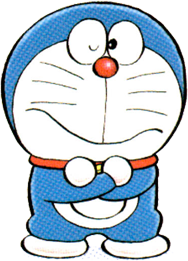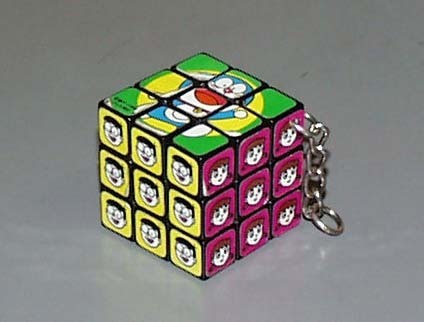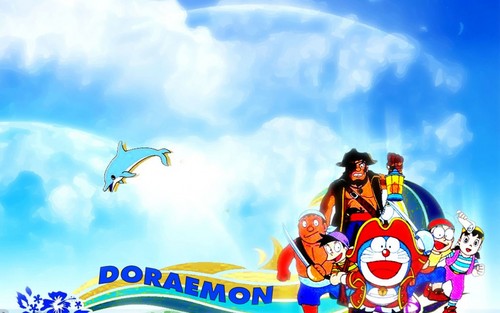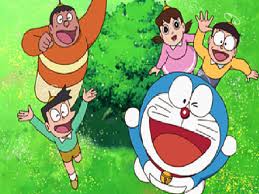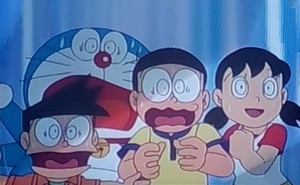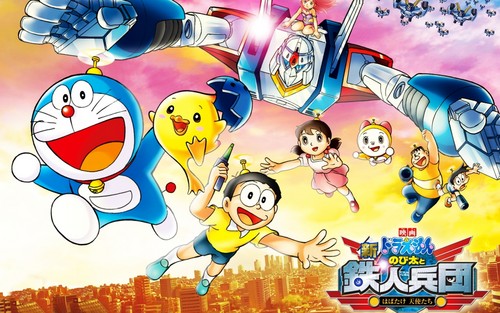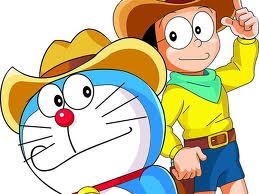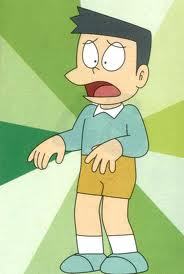An earless blue robotic cat, one pocket bulging with gadgets from the future and a lifelong fear of mice: Who is he? Japan roars the answer — but English readers may be stumped. Because, even though he’s a government-appointed “cultural ambassador” and a familiar face in more than 30 countries, with his antics translated into dozens of languages, there has never been an official English version of the manga in which he stars. Until now.
“I would say there are very few Japanese people, of any age group, who’ve never heard of Doraemon,” believes Matt Alt, of AltJapan, the company in charge of translating and localizing the “Doraemon” manga for English speakers. “Doraemon is A-grade Japanese pop culture, and Japan’s single most popular character if you are looking at things in terms of gross sales and merchandising. He’s been with us literally for decades.”
Forty-five years to be exact. And Fujiko Pro, the company formed by Hiroshi Fujimoto, the Japanese manga artist who created “Doraemon” under the pen name of Fujiko F Fujio, hopes the friendly robot cat is ready for his ABC’s. “Up until now, ‘Doraemon’ comics have been widely translated in Asia and Europe. We now want to focus on areas that have not yet experienced an official comic version of ‘Doraemon,’ starting with North America,” says a Fujiko Pro spokesperson.
Fujiko Pro carefully weighed many considerations in preparing Doraemon’s adventures for North American audiences. For one, the sheer bulk of the comic made projected expenses for a print version daunting. Serialized since 1969, a total of 1,300 stories were created in the original run published by Shogakukan and extending to over 45 volumes of work — that’s over 12,000 pages of manga!
As the company’s spokesperson explains, “‘Doraemon’ started as a manga. It’s important to us to release it as close as possible to the original, in a format that can be easily available to North American readers.” Working under the guidelines of the Subsidy for the Localization and Promotion of Japanese Visual Media (J-LOP), which “aims to promote awareness and appreciation of Japanese visual media in overseas markets,” Fujiko Pro chose the Harajuku, Tokyo-based Voyager, a leading creator of e-books, to release the series in its entirety — digitally.
Voyager then outsourced the translation aspect to AltJapan.
Alt started the company together with Hiroko Yoda, now his wife, in Tokyo in 2003. Working together as a translation team in the United States since the early 1990s, the couple moved to Japan to feed a growing demand for entertainment localization.
Voyager approached Alt and Yoda in Tokyo at the 2013 Digital Comic Associations “Manga Translation Battle” where Alt had just finished a panel discussion. “I was shocked when Voyager came up afterwards and asked us to translate ‘Doraemon,'” says Alt. “Not only because I was surprised it had never been done before, but as someone who was raised on Japanese pop culture, it was an honor to get to work on a series with as much cultural impact as ‘Doraemon.'”
“We spent days and nights working with these characters, and now that we’re finished, there’s like this robot-cat-shaped hole in my heart right now,” says Alt, explaining that he would literally read the lines aloud once they had translated them, while Yoda would check them against the Japanese: “That vocalizing of the dialog really helps to capture a natural cadence.”
Alt also credits Fujiko Pro for allowing necessary tweaks in English. “Fujiko Pro was very supportive in wanting to make this something that resonates naturally in the target language, making readers feel ‘Doraemon’ was written just for them. That’s the whole point of localization,” Alt explains.
One important area for change was the English naming of characters. Fujiko Pro decided to alter some of the characters’ names for a variety of reasons. “Nobita,” it was felt, sounded feminine in English, so they went with “Noby.” Meanwhile, “Suneo” sounds very close to “snail” when said aloud in English, and so the team decided to go with the more native-sounding “Sneech,” which “captured his essence a little better.” And finally, in the case of “Giant,” “the name itself may imply a blank/slow personality, so we decided to go with ‘Big G.'”
Translating the names of Doraemon’s spectacular gadgets was another key part of the process. “Nearly every episode centers on the gadgets Doraemon pulls out to help his bumbling friend Noby make it through life,” explains Yoda. “Many of the names are puns or plays on words and we were given a lot of freedom to brainstorm and rewrite them in whatever way would capture the essence of each gadget.”
Take-coputā, for example, became “hopter” since it lets you hop from place to place; others translated directly, such as Dokodemo doa became “Anywhere door.”
“One of the critical parts of this project was maintaining a glossary of the translations of all of Doraemon’s gadgets,” explains Yoda. “I started building an Excel file of them starting with the first episode, and by the end we had over 1,500 of them!”
Once he passes the initial North American test, Doraemon may just go anywhere in English. As the people behind him say, “Fujiko F Fujio wrote a many great manga in addition to ‘Doraemon.’ We hope ‘Doraemon’ can open the door for other Fujiko F Fujio works to be seen by an English-speaking audience.” For Doraemon, with his Anywhere door, that should be a cinch.
“I would say there are very few Japanese people, of any age group, who’ve never heard of Doraemon,” believes Matt Alt, of AltJapan, the company in charge of translating and localizing the “Doraemon” manga for English speakers. “Doraemon is A-grade Japanese pop culture, and Japan’s single most popular character if you are looking at things in terms of gross sales and merchandising. He’s been with us literally for decades.”
Forty-five years to be exact. And Fujiko Pro, the company formed by Hiroshi Fujimoto, the Japanese manga artist who created “Doraemon” under the pen name of Fujiko F Fujio, hopes the friendly robot cat is ready for his ABC’s. “Up until now, ‘Doraemon’ comics have been widely translated in Asia and Europe. We now want to focus on areas that have not yet experienced an official comic version of ‘Doraemon,’ starting with North America,” says a Fujiko Pro spokesperson.
Fujiko Pro carefully weighed many considerations in preparing Doraemon’s adventures for North American audiences. For one, the sheer bulk of the comic made projected expenses for a print version daunting. Serialized since 1969, a total of 1,300 stories were created in the original run published by Shogakukan and extending to over 45 volumes of work — that’s over 12,000 pages of manga!
As the company’s spokesperson explains, “‘Doraemon’ started as a manga. It’s important to us to release it as close as possible to the original, in a format that can be easily available to North American readers.” Working under the guidelines of the Subsidy for the Localization and Promotion of Japanese Visual Media (J-LOP), which “aims to promote awareness and appreciation of Japanese visual media in overseas markets,” Fujiko Pro chose the Harajuku, Tokyo-based Voyager, a leading creator of e-books, to release the series in its entirety — digitally.
Voyager then outsourced the translation aspect to AltJapan.
Alt started the company together with Hiroko Yoda, now his wife, in Tokyo in 2003. Working together as a translation team in the United States since the early 1990s, the couple moved to Japan to feed a growing demand for entertainment localization.
Voyager approached Alt and Yoda in Tokyo at the 2013 Digital Comic Associations “Manga Translation Battle” where Alt had just finished a panel discussion. “I was shocked when Voyager came up afterwards and asked us to translate ‘Doraemon,'” says Alt. “Not only because I was surprised it had never been done before, but as someone who was raised on Japanese pop culture, it was an honor to get to work on a series with as much cultural impact as ‘Doraemon.'”
“We spent days and nights working with these characters, and now that we’re finished, there’s like this robot-cat-shaped hole in my heart right now,” says Alt, explaining that he would literally read the lines aloud once they had translated them, while Yoda would check them against the Japanese: “That vocalizing of the dialog really helps to capture a natural cadence.”
Alt also credits Fujiko Pro for allowing necessary tweaks in English. “Fujiko Pro was very supportive in wanting to make this something that resonates naturally in the target language, making readers feel ‘Doraemon’ was written just for them. That’s the whole point of localization,” Alt explains.
One important area for change was the English naming of characters. Fujiko Pro decided to alter some of the characters’ names for a variety of reasons. “Nobita,” it was felt, sounded feminine in English, so they went with “Noby.” Meanwhile, “Suneo” sounds very close to “snail” when said aloud in English, and so the team decided to go with the more native-sounding “Sneech,” which “captured his essence a little better.” And finally, in the case of “Giant,” “the name itself may imply a blank/slow personality, so we decided to go with ‘Big G.'”
Translating the names of Doraemon’s spectacular gadgets was another key part of the process. “Nearly every episode centers on the gadgets Doraemon pulls out to help his bumbling friend Noby make it through life,” explains Yoda. “Many of the names are puns or plays on words and we were given a lot of freedom to brainstorm and rewrite them in whatever way would capture the essence of each gadget.”
Take-coputā, for example, became “hopter” since it lets you hop from place to place; others translated directly, such as Dokodemo doa became “Anywhere door.”
“One of the critical parts of this project was maintaining a glossary of the translations of all of Doraemon’s gadgets,” explains Yoda. “I started building an Excel file of them starting with the first episode, and by the end we had over 1,500 of them!”
Once he passes the initial North American test, Doraemon may just go anywhere in English. As the people behind him say, “Fujiko F Fujio wrote a many great manga in addition to ‘Doraemon.’ We hope ‘Doraemon’ can open the door for other Fujiko F Fujio works to be seen by an English-speaking audience.” For Doraemon, with his Anywhere door, that should be a cinch.







